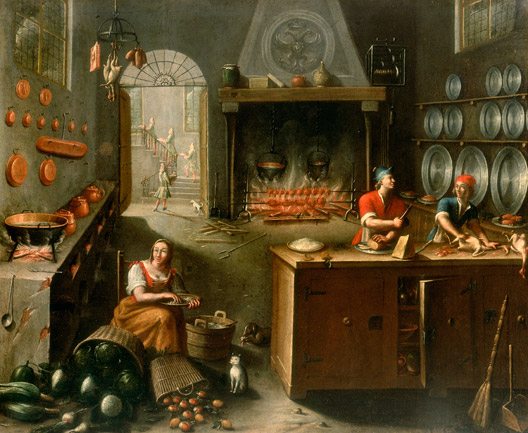Fr : version française / En: english version
Roasting, frying, grilling, boiling and braising
Grilling and roasting were the forerunners in a slow evolution of the gastronomic arts. The food is in direct contact with the flames, which char its surface and cook it through. The first refinement came with the idea of using an intermediary, such as water or fat for boiling and frying, between the heat and the food.
Theory of frying
Liquids which you subject to the action of fire cannot all receive the same quantity of heat. Nature has formed them differently, and this secret, which we will call CAPACITY FOR CALORIC, she has kept to herself.
You may, therefore, with impunity dip your finger in boiling spirits of wine; you would take it very quickly from boiling brandy; more rapidly yet from water; while the most rapid immersion in boiling oil would heat you easily.
Consequently warm fluids act differently on the sapid bodies presented to them. Those subject to water soften, dissolve, and reduce themselves to boilli. The result is bouillon and its extracts. Those on the contrary treated with oil harden, assume a color more or less deep, and finally are carbonized.
In the first instance, water dissolves and conveys away the interior juices of the alimentary substances placed in it. In the second the juices are preserved, for they are insoluble in oil. If these things dry up it is because a continuous heat vaporizes the humid parts.
The two methods have different names, and FRYING is BOILING in oil or grease substances intended to be eaten. I think I have told you that officially oil and grease are synonymous; heating the latter being but a concrete oil.
Fritures are well received in entertainments into which they introduce an agreeable variety. They are agreeable to the taste, preserve their primitive flavor, and may be eaten with the hand, a thing women are always fond of.
Thus cooks are able to hide many things that have appeared on the day before, and remedy unforeseen requisitions on them. It takes no longer to fry a four pound chop than it does to boil an egg.
All the merit of the friture is derived from the surprise, or the invasion of the boiling liquid which carbonizes or burns at the very instant of immersion of the body placed in it.
To effect a purpose, the liquid must be hot enough to act instantaneously. It does not, however, reach this point until it has long been submitted to the action of a blazing and hot fire.
By the following means it may be ascertained if the friture be heated to the wished-for degree, cut a piece of bread in the form of a cube, and dip it in the pan for five or six seconds, if you take it out firm and dark put in what you wish to prepare immediately. If it be not, stir the fire and begin again.
Excerpted from "The Physiology of Taste" by Jean Anthelme Brillat-Savarin, 1826
Translated from the last Paris edition by Fayette Robinson.
The different cooking methods can be recombined in an infinite number of variations, depending on the material and shape of the receptacle used (hence the French word "recette" is "recipe" in English) and ever-finer control of cooking temperatures. However, cooking is not simply a question of nourishment or flavors, as the degree of ostentation associated with meals is an obvious marker of social status.





























